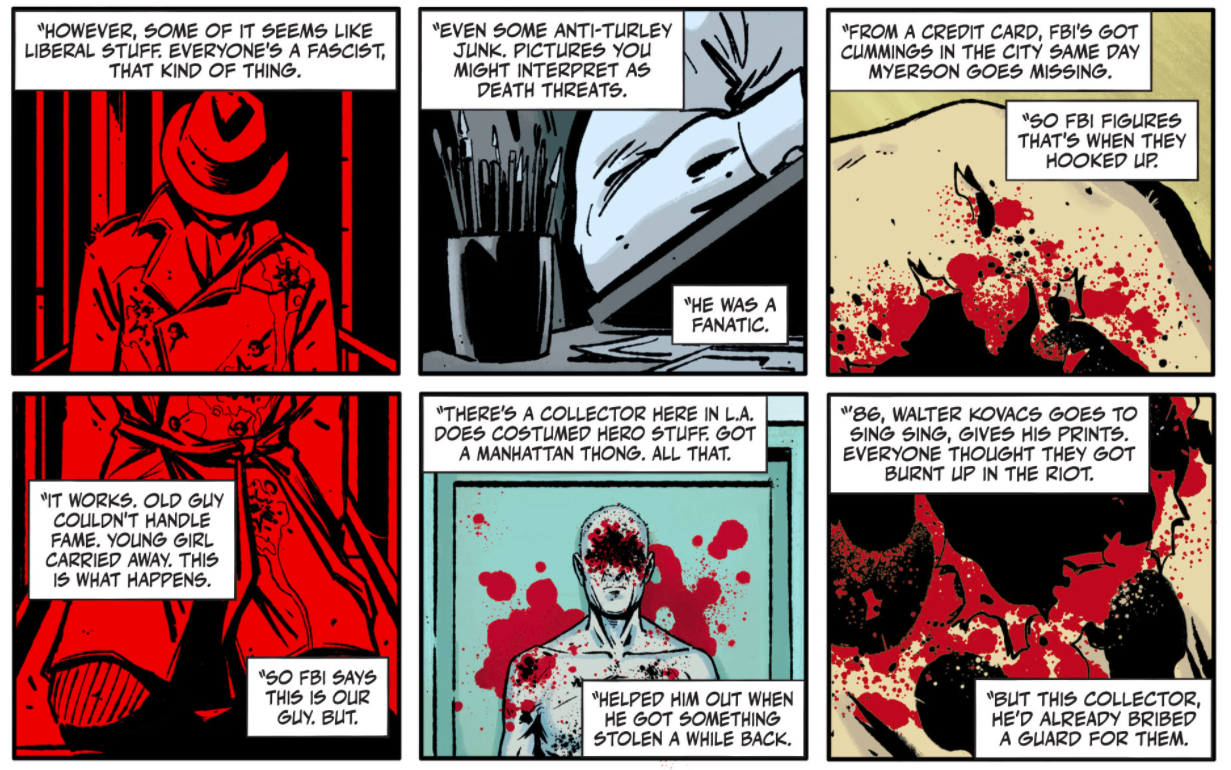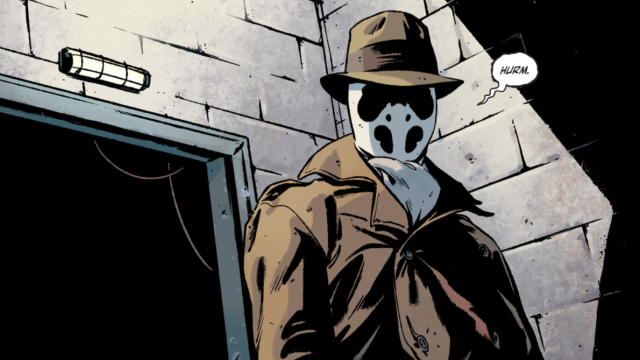When Walter Kovacs made clear that he was willing to reveal the truth behind Adrian Veidt’s plan to bring about world peace by dropping a telepathic squid on Manhattan at the end of the original Watchmen comic, Doctor Manhattan made the sensible decision to kill Kovacs in order to avert yet even larger catastrophe.

DC’s new Rorschach ongoing series from writer Tom King, artist Jorge Fornés, colorist Dave Stewart, and letterer Clayton Cowles picks up in Watchmen’s original universe in the year 2020, with the entire world believing its titular conspiracy-minded vigilante to be quite dead.
But as issue #1 opens, Rorschach establishes its core mystery with the death of someone who, from all appearances, seems to be Rorschach. Or at least, someone pretending to be him. High above an uproarious political rally for a politician called Turley who’s running against Robert Redford in the presidential race, the modern-day Rorschach, along with his domino-masked female partner, are shot dead by security guards who believe the pair were attempting to pull off an assassination.
The botched assassination is cause for alarm enough, but this particular attempt gained special attention in part because these sorts of crimes involving people wearing costumes have a heightened significance in this world. Rorschach follows as a special agent dives into an investigation into the identities of the would-be assassins; surprisingly, it doesn’t take long for the authorities to find a suspect: cartoonist William Myerson. An anti-Turley conspiracy theorist who was best known for creating and illustrating Pontius Pirate comics in the 60s — akin to the Tales of the Black Freighter metanarrative comic from the original Watchmen — before withdrawing from public life, Myserson partnered with a young woman named Laura Cummings to dress up as costumed vigilantes and plan the supposed assassination. But the agents can’t be absolutely certain that Myerson’s their Rorschach, as the bullet that killed him went right through his head, leaving most of it mangled beyond recognition — and because Myerson lived virtually off the grid, there are no fingerprints on file to cross-reference.
Fornés and Stewart’s illustrations in Rorschach #1 are bold and striking in a way that evokes a very specific crime procedural element that expertly compliments the story. You see just what sort of gruesome imagery the creative team’s able to lead with because of Rorschach being a Black Label title, as our lead investigator pores over bloodied autopsies and flashes back to crime scenes to uncover the truth of the situation.
While the agents don’t initially have much to go on in terms of figuring out exactly how Myerson and Cummings became involved with one another and set out to assassinate a presidential candidate, Myerson’s choice of mask leads them to believe he’s just another crackpot with a fondness for costumes. But as Rorschach’s first issue builds to its first climax, the agents looking into Myerson realise something’s rather off.

It should be impossible for the dead body’s fingerprints to match those of Walter Kovacs, but one of the agents looking into the case figures there’s no hurt in looking into the possibility anyway. He takes it upon himself to obtain a copy of Kovacs’ prints from a Minutemen fan, who himself gained them by bribing a guard at Sing Sing prison, where Kovacs was once held prisoner, as depicted in the original Watchmen. Much to the agent’s surprise and confusion, the corpse and Kovacs’ fingerprints are a perfect match with one another, suggesting that somehow Kovacs didn’t actually die back in 1985 the way Watchmen led everyone to believe.
Rorschach treats the revelation of the link between the dead body and Kovacs as if it’s the most shocking thing that could come to light. While that might be the case for the people in-universe, within a larger context — DC’s repeatedly borrowed elements from the Watchmen universe to do wild things to its own core universe (see: Doomsday Clock) — “how could Rorschach possibly be back from the dead?” isn’t nearly as mind-boggling a question as Rorschach seems to think it is. This is a world in which a megalomaniacal man hired a team to create a fake alien squid in order to scare the world into becoming a better place. Surely, cloning isn’t out of the realm of possibility, nor is the chance that Doctor Manhattan in all of his unique brand of objective wisdom saw fit to give Kovacs a second chance at life.
All of these are potential directions that Rorschach could end up going, but the first issue doesn’t quite set itself up in a way that makes any of the potential answers seem interesting. “What if X character came back from the dead?” is a tried and true comics premise that can lead to fascinating storytelling, but in 2020, approaching a character like Rorschach with that kind of energy begs the question: “why?”

Comments